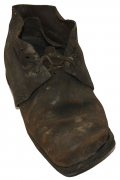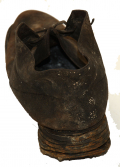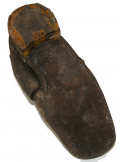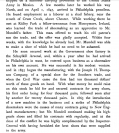site search
online catalog
SCARCE CIVIL WAR ARMY ISSUE SHOE MADE AND MARKED BY CIVIL WAR CONTRACTOR JOHN MUNDELL OF PHILADELPHIA
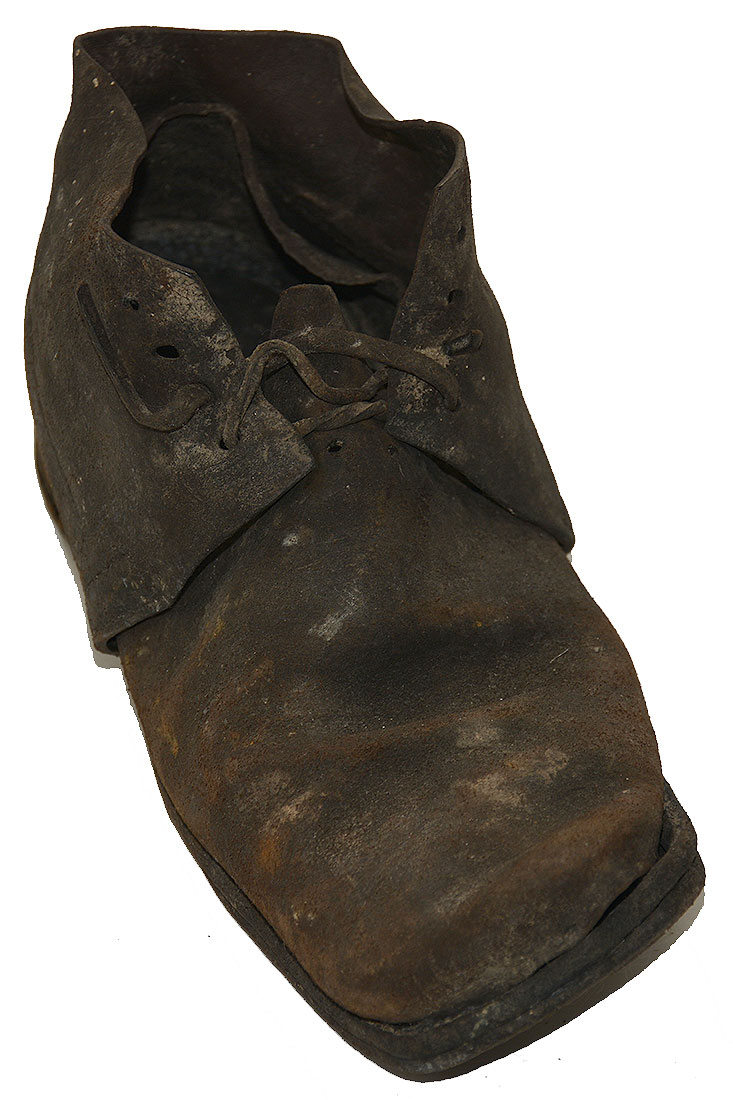
$1,850.00
Quantity Available: 1
Item Code: 1052-298
Shipping: Determined by Method & Location of buyer
To Order:
Call 717-334-0347,
Fax 717-334-5016, or E-mail
This is a typical, though very scarce, Civil War issue army shoe made by a known contractor and marked by him on the inside of the ankle: “J. MUNDELL.” Mundell was born in Ireland in 1829, reached Philadelphia in 1847, and worked for time “in the government shoe factory in the Schuylkill Arsenal.” In the mid-1850s he partnered in making a “special shoe for the southern trade,” which was likely a euphemism for cheap shoes for southern slaves, and later used this experience in making army shoes on contract in the Civil War.
A short biography can be found in Vol. 3 of Prominent and Progressive Pennsylvanians of the Nineteenth Century (Williamson et al. 1898.) The relevant passage reads as follows:
“He soon secured work at the Government shoe factory in the Schuylkill Arsenal, and , within a year after he had arrived in Philadelphia in want , he entered upon business as a shoemaker on his own account . He was successful in his modest venture, and in 1855 began the manufacturing , with the Joseph H. Thompson Company, of a special shoe for the Southern trade, and when the Civil War came the firm had ten thousand dollars' worth of these goods on hand. With what money he could raise on this stock he bid for and secured contracts for army shoes, his first order being for four thousand pairs, followed soon after by another for twenty thousand pairs. In 1863 the introduction of a new machine in the business and a strike of Philadelphia shoemakers were the causes of many contracts going to New England manufacturers; but Mr. Mundell continued making his high-grade shoes and filled his contracts with regularity , and at the close of the conflict he was highly complimented by the Inspector-General with having furnished the best shoes that were supplied to the army.”
This shoe is typical wartime construction, complete, very displayable and able to be handled. The leather is very stiff, but is typical in having rough-side-out black leather uppers consisting of sewn vamp and quarters with reinforcing heel piece or “counter” sewn inside, four pairs of holes for a leather lace (thong,) with two additional holes at the base of the tongue, rather square toe, and sewn soles. The heel is made of four layers secured by nails that are corroded, but present, with the layers separating a bit but secure. The instep on the left has a narrow separation between it the insole, which seems to be from the stitching having given way, but the leather is stiff and the shoe is solid, with the opening only visible when the shoe is turned on its side. Part of the original shoelace is in place through two pairs of holes. The maker mark is very clear, just under the right edge at the ankle.
By appearance and feel this would be taken as a barn or attic-find, but was in fact excavated at in Fort Pembina in wonderful anaerobic conditions that have yielded cloth and leather in remarkable condition. (Think of the British Roman fort a Vindolanda, which has offered up two-thousand year-old sandals, writing tablets, etc., in excellent condition.) In this case the military fort was U.S. Army Indian War post established in 1870, a period in which the army was still using up its vast surplus stocks of Civil War uniforms and equipment and this shoes follows fully the Civil War pattern, which was replaced gradually after the adoption of a modified pattern in 1872 using brass screws to secure the soles, and later patterns in 1876 and 1886, that reintroduced stitching, but were very different in overall look and design.
Being so readily worn out and discarded, practical for postwar civilian use, and uninspiring as relics of patriotic service, Civil War U.S. Army issue shoes are among the rarer pieces of Civil War uniforms and equipment despite being made in the millions. They fall into general categories by construction: with soles that are pegged and with those that are sewn, further broken down whether done by hand or machine, with the shoes both made at some depots or purchased from contractors through the depots for distribution. The numbers involved are prodigious. Philadelphia depot, for example, purchased some 3,231,647 pairs of sewn shoes and made others. New York distributed almost three million sewn pairs and well over three-hundred thousand pegged pairs. Cincinnati furnished more than two million pegged pairs and six million sewn. Some considered the soles too thin, but they were generally well regarded for use on southern roads, “where one hardly strikes a pebble in a mile.” It was complaints coming from troops serving in the southwest where rough and rocky ground would cut stitching and tear off heels and cause wood pegs to pop out from dryness that led to the use of brass screws starting in starting with the pattern of 1872 and continued in the pattern of 1876, with the addition of a longer tongue. We recommend “The Army Shoe” by J.E. Tobey in the Columbia Rifles Research Compendium, as well as articles in Company of Military Historians, Brinkerhoff’s Boots and Shoes of the Frontier Soldier, and McChristian’s excellent volumes on the postwar US army.
The excavations at Fort Pembina were conducted on private property with the owner’s permission, and is in a remarkable state of preservation from the anaerobic conditions of the soil. The fort was established in 1870 by troops of the 20th US Infantry
Situated in the Red River Valley in North Dakota near the Canadian border, was established in 1870 and in operation until 1895. Trading posts existed earlier in the area as part of the fur trade, and the first U.S. military post there was temporary- manned by a detachment of Minnesota troops in 1863-1864 following the 1862 Sioux uprising. In March 1870 a new fort was established south of the Pembina River and about 200 yards west of the Red River, completed by July and named in honor of Gen. George H. Thomas. The name was changed to Fort Pembina in September and the initial garrison consisted of two companies of the 20th US Infantry and as is typical of the early Indian Wars regular army, their uniforms and gear were a mix of Civil War surplus issue, private purchase material, and later army issue patterns and private purchases as time went on. Their main duty was to provide security for settlers worried about Sioux returning south from Canada, but the troops were more occupied with escorting boundary surveys along the Canadian border and preventing Fenian raids heading north into Canada.
The fort included enlistedmen’s barracks, officers’ quarters, guard house, ordnance storehouse, company kitchen, root house, laundress’s quarters, quarters for civilian employees, hospital and hospital servant’s house, a barn for the “hospital cow,” quartermaster and commissary offices and storehouse, stables, wagon shed, etc. The garrison reached peak strength in 1878 af 200, but the average was about 125 enlisted men and 8 officers. An October 1885 return listed 97 men, 2 field pieces, 1 mountain howitzer, 100 rifles, 19 pistols, 23 mules, and 9 wagons. By 1890 the post had just 23 men, and after an 1895 fire destroyed some 19 buildings it was decided to abandon the fort rather than rebuild, the last detachment left in September. The property was turned over to the Interior Department and later sold in 1902. Recent excavations have taken place on private property with the owner’s permission. [sr] [ph:L]
~~~~~~~~~~~~~~~~~~~~~~~~~~~~~~~~~~~
THIS ITEM, AS WITH ALL OTHER ITEMS AVAILABLE ON OUR WEB SITE,
MAY BE PURCHASED THROUGH OUR LAYAWAY PROGRAM.
CLICK HERE FOR OUR POLICIES AND TERMS.
THANK YOU!
Inquire About SCARCE CIVIL WAR ARMY ISSUE SHOE MADE AND MARKED BY CIVIL WAR CONTRACTOR JOHN MUNDELL OF PHILADELPHIA
For inquiries, please email us at [email protected]
Most Popular
Historical Firearms Stolen From The National Civil War Museum In Harrisburg, Pa »
Theft From Gravesite Of Gen. John Reynolds »
Cavalry Carbine Sling Swivel »
Fine Condition Brass Infantry Bugle Insignia »
featured item
CIVIL WAR COMMODORE’S UNDRESS FROCK COAT OF SILAS H. STRINGHAM, USN: LEADER OF THE FIRST COMBINED OPERATION OF THE UNION NAVY AND ARMY IN THE CIVIL WAR; VICTOR OF THE BATTLE OF HATTERAS INLET BATTERIES
Fought on Aug. 28-29, 1861, little more than a month after the Union defeat at Bull Run, the capture of Forts Hatteras and Clark on the outer banks helped restrict Confederate blockade running, enabled further operations on the North Carolina coast,… (1179-504). Learn More »



